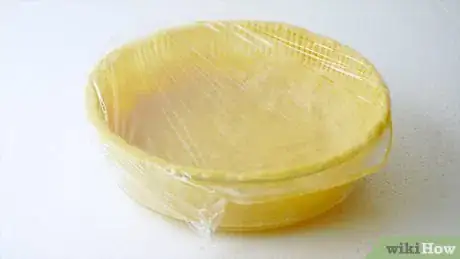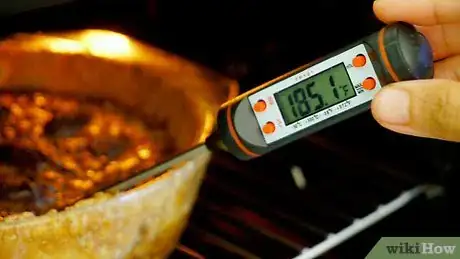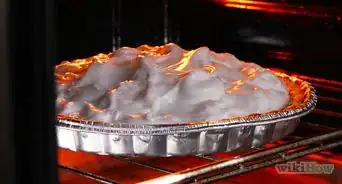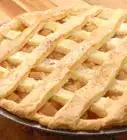This article was co-authored by wikiHow Staff. Our trained team of editors and researchers validate articles for accuracy and comprehensiveness. wikiHow's Content Management Team carefully monitors the work from our editorial staff to ensure that each article is backed by trusted research and meets our high quality standards.
There are 11 references cited in this article, which can be found at the bottom of the page.
The wikiHow Video Team also followed the article's instructions and verified that they work.
This article has been viewed 59,508 times.
Learn more...
Pecan pie is a delicious dessert that is notoriously difficult to bake well because it can be difficult to tell when it is done. The crust and the pecans can burn easily if overcooked, but the middle can come out runny if it’s not cooked long enough. With the right techniques, however, you can bake a perfectly gooey and crunchy pecan pie every time.
Steps
Par-Baking Your Crust
-
1Use a thermometer to test your oven’s temperature. Before you bake anything in your oven, make sure you know what temperatures its reaching inside. Oven thermometers simply sit inside your oven and provide a more accurate reading of the internal temperature of your oven than your oven’s own thermostat.[1]
- For example, if your oven is set to 350 degrees F (177 degrees C), but the thermometer inside shows a reading of only 325 degrees F (177 degrees C), you will need to turn up your thermostat until it reaches the correct temperature reading.
-
2Place your crust in a clear pie dish. Look for a clear, glass pie dish at any store that sells baking supplies or online. Line your dish with your pie crust as you normally would. [2]
- The clear dish will give you a nice even bake for a crisp, golden crust. It will also allow you to see how the crust is cooking on the bottom.
Advertisement -
3Freeze your pie crust for at least 20 minutes. Once you’ve made your pie crust, freeze it to prevent the dreaded soggy bottom pie. This step also prevents the pie shell from shrinking when all the fat in the crust melts and it gives you a crisp bottom for your filling.[3]
- If your crust will be in the freezer for more than 30 minutes, wrap it in plastic wrap. If the crust was pre-frozen or if you put it in the freezer for more than 4 hours, place it in your refrigerator for about 30 minutes before you bake it.
-
4Line your crust with foil or parchment paper and pie weights. Known as blind baking, this step prevents the pie crust from puffing up when cooked. Cut a piece of parchment paper or foil large enough to fill the inside of your pie crust. Place your weights on top of the parchment.[4] Use enough to cover the entire bottom of your pie crust.[5]
- Buy pie weights at a store that sells baking supplies or online.
- As an alternative, use sugar, dried beans, lentils, or rice to weight down your crust.
- The choice between foil and parchment varies from baker to baker. Foil can help prevent overbrowning on your crust’s edges, while parchment is less likely to stick into the crust.
-
5Bake your crust at 350 degrees F (177 degrees C) for 45 to 50 minutes. Keep your pie crust in the oven with the pie weights for the duration of the cooking time. Remove it from the oven and remove the pie weights when finished. Now you’re ready to add your filling and bake![6]
- The temperature and timing of your par-bake may vary depending on the exact recipe you use.[7]
Looking for Signs of Doneness
-
1Follow your recipe to add the filling and bake. There are dozens of ways to make pecan pie. Search online for a recipe that has good reviews. Read the comments on the recipe to learn about potential problems and how to address them.
- Bake your pie according to the instructions but keep a watch over it.
- Check on your pie midway through the baking time, and again every 10-15 minutes after that to look for signs of doneness.
-
2Look for a medium-brown color on the pecans. When a pecan pie is done, the top of the pie has a caramelized look to it. A nice medium- to dark-brown top with a golden-edged crust is a good indication the pie may be finished.[8]
-
3Check the pie for the perfect amount of jiggle. The jiggle test is a must when making custard pies like a pecan pie. Pull it out of the oven and give it a gentle shake. If this prompts a flowing wave-like movement throughout the pie’s filling, then your pie isn’t done yet.[9]
- The perfect amount of jiggle will mimic what you would see if you shook a bowl of gelatin.
- Your inside edges should be stable, the middle should maintain some of that movement.
- Look for a bit of puffiness at the edges of the pie, along the crust. This is also a good indicator that the filling has set properly.
- If you wait too long, the surface of the pie may crack when it cools. This is an indication your pie is over-cooked.
-
4Look for an internal temperature of 185 degrees F (85 degrees C). If you’re really not sure if the pie is done, you can check that it has reached the proper internal temperature with an instant-read thermometer. Stick the thermometer’s probe into the center of your pie and wait for the temperature reading to stabilize.[10]
- Buy an instant thermometer at any store that sells baking supplies, or online.
Things You’ll Need
- Oven thermometer
- Pie crust dough
- Pecan pie filling
- Clear glass pie dish
- Freezer
- Parchment paper or aluminum foil (according to your preference)
- Pie weights (or sugar, rice, dried beans, or dried lentils)
- Instant-read thermometer (if desired)
References
- ↑ https://youtu.be/piTseQRhxBY?t=29
- ↑ https://youtu.be/piTseQRhxBY?t=57
- ↑ https://sallysbakingaddiction.com/how-to-blind-bake-pie-crust/
- ↑ https://sallysbakingaddiction.com/how-to-blind-bake-pie-crust/
- ↑ https://www.youtube.com/watch?v=O0pVTk5tREQ
- ↑ https://www.simplyrecipes.com/recipes/how_to_blind_bake_a_pie_crust/
- ↑ https://sallysbakingaddiction.com/how-to-blind-bake-pie-crust/
- ↑ https://www.realsimple.com/food-recipes/cooking-tips-techniques/baking/how-to-tell-pecan-pie-done
- ↑ https://www.realsimple.com/food-recipes/cooking-tips-techniques/baking/how-to-tell-pecan-pie-done























































